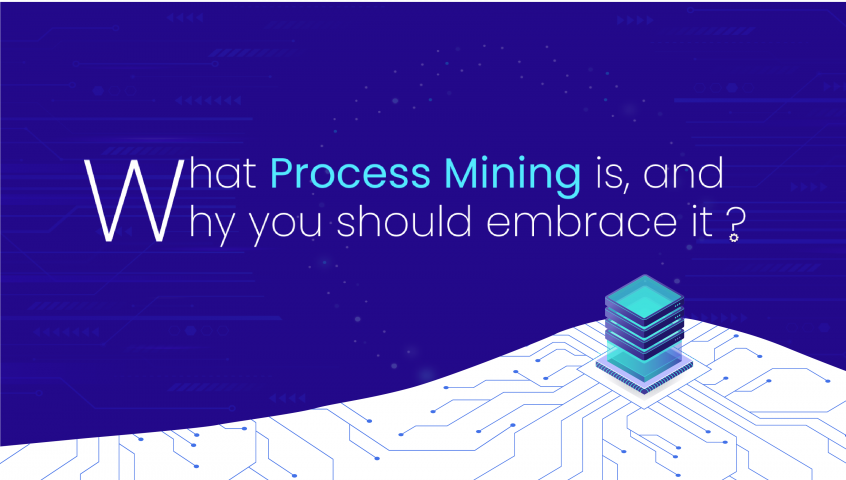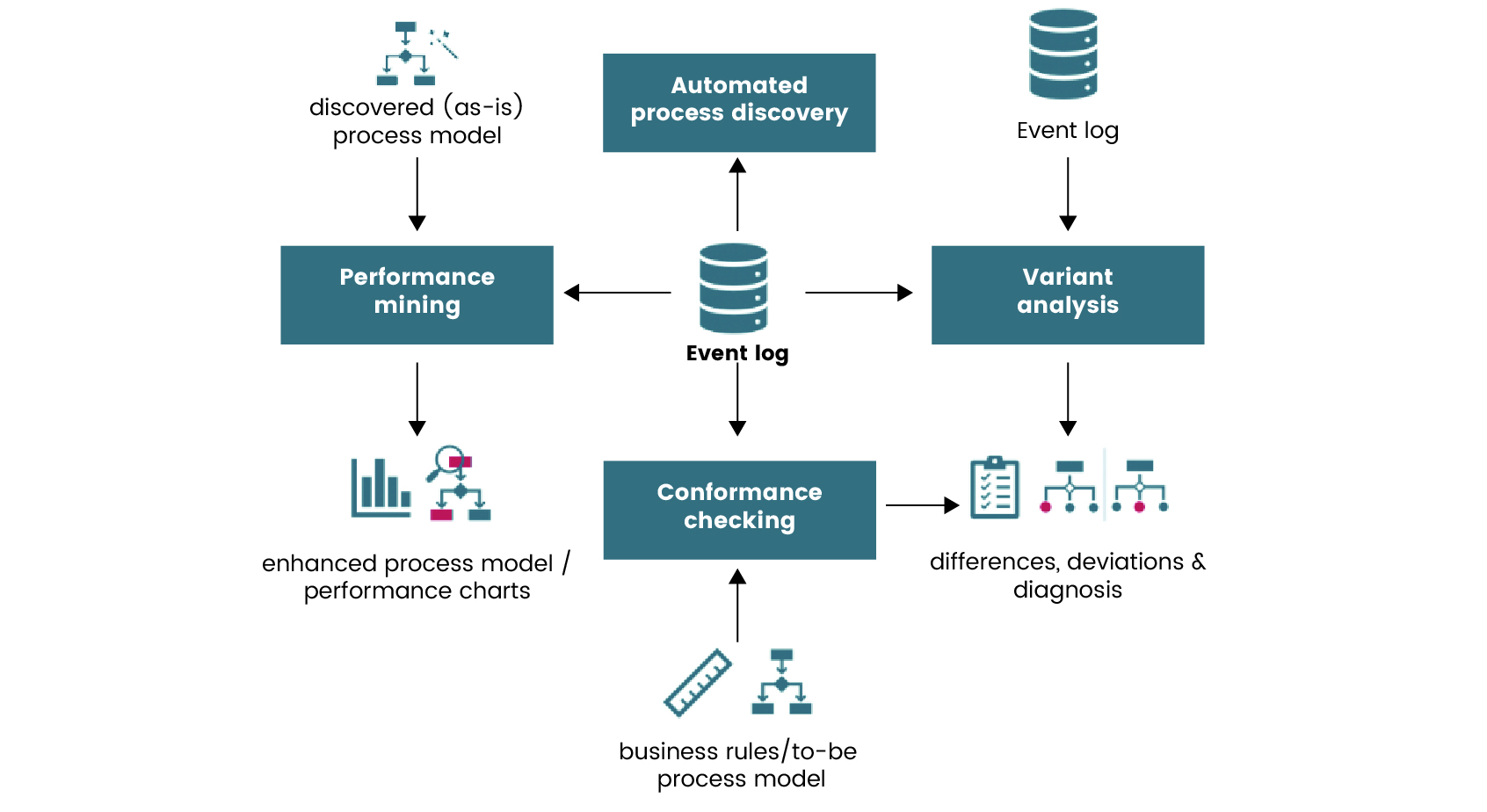
Businesses are drowning in data from all the systems that run their processes—from enterprise resource planning to supply chain management and all points in between. For most, this means these systems spend most of their time running in the background, collecting data but doing nothing with it. However, it’s possible to turn this massive stream of data into meaningful insights that can be actionable in real-time with Process Mining. Even though the name might sound complicated, the thing itself is not. In the same way a miner digs into the earth to uncover valuable resources, process mining gives businesses real-time insight into how their current processes really work, regardless of the complexity. To succeed in your target market, you need access to real-time, actionable business information that gives you more options for improving and refining your operations. In this article, we will discuss more about what process mining is, why it matters, and how it can help your businesses reach new heights of success!
What is Process Mining and Why it is so important?
Most businesses have only a rudimentary knowledge of how their processes work. In the last decade or two, process mining has become a critical enabler for business intelligence and business process management. It has become an essential part of the modern business landscape, from banking and financial services to telecommunications, energy, healthcare, logistics, and manufacturing. Many companies gain valuable insights from mining their processes, allowing them to review thoroughly and devise action plans.
According to studies, businesses are embracing process mining solutions at a breakneck pace. The global software market is expected to grow at a CAGR of 49.3 percent during the forecast period, from $627.0 million in 2021 to $10,383.0 million in 2028.
Process mining is a collection of data-driven techniques for examining business processes by extracting event data from information systems such as Enterprise Resource Planning (ERP), Customer Relationship Management (CRM), Electronic Health Records (EHR) to name a few. Business users can use this technique to find bottlenecks, deviations, and inefficiency in their processes, as well as opportunities to improve performance and maximize positive business outcomes.

It can help you gain insight quickly and accurately. These tools collect and visualize process data, making it easy to spot problem areas. They do this by keeping digital records of each process’s activities as an event log. The event log data is then processed and presented as an easy-to-follow flowchart. Here, potential issues are visible making it easier to identify and eliminate inefficiencies that are impacting your business. In addition, it can help you measure the performance of your efforts and look for more possibilities to improve.
How does process mining work?
It allows all stakeholders to examine data to improve operational performance, optimize processes, and identify process aberrations that impact the business.

- Analyze and transform data - The majority of firms now collect and retain information about their workflows in a database. Using process mining technologies, you may create event logs for each of your organization’s processes using these data sets. The software assigns a timestamp, a case ID, and an activity to each item of data. These three parts aid the application in better analyzing and prioritizing different areas of your workflows.
- Examine the specifics of each step in the process - Following the creation of event logs, it generates process graphs that expose every small step in each of your workflows. With these detailed graphs, you can identify your organization’s inefficiencies and find solutions for improving them.
- Set Priorities - Your processes can be visualized with process mining tools, including the exact time to complete various subtasks. With this data, you’ll be able to identify which aspects of your workflows need the most attention and how to go about making those fixes. It can also help you determine how much time and cost your proposed changes will save before you implement them.
- Monitor your workflows - Even after you’ve made enhancements to your workflows, process mining software will continue to analyze and evaluate your processes. This can assist you in collecting and analyzing real-time data to determine whether the modifications you’ve implemented have been effective. It can also help you identify if your workflows adhere to company policies or constraints.
Process Mining Techniques
The techniques and strategies revolve around the event log and fall into four categories:

Automated process discovery - Automatic process discovery uses an event log to create an “as-is” model that shows how the process works and can be compared to how the business expects it to. Using Automated Process Discovery, firms can see the process in action and identify areas where automation or other improvements can be made. It identifies the actual process flow, decision points, intervention points, who makes them, rework and redundant work, and where employee handoffs occur. Automated process discovery step is critical for achieving process transparency, which is required to build a process improvement plan.
Conformance Checking - Conformance checking is used to determine whether the business processes being recorded in the system comply with current business rules, regulations, and norms. Conformance checking enables us to identify discrepancies between the actual process and a model process. We can also use it to look for infringements on compliance rules.
Performance mining - Performance mining is the act of examining the process’s performance from several angles in order to determine which steps, flows, and other aspects of the process require the greatest attention or deserve automation investment. This is accomplished using model enhancement. Model enhancement refers to extending or annotating a process model with performance metrics. The enhancement model reveals problematic processes, bottlenecks, time-consuming and costly process steps, rework loops, prematurely terminated cases, and other points of friction.
Variant analysis - Organizations can easily compare two or more versions of one business process using process mining software. The event log is often divided into two main sets of variants, one focusing on cases with a positive outcome while the other depicts cases with a negative outcome. Companies can then use this data to better understand how their processes differ and come up with data-driven improvement suggestions.
Benefits of Process Mining
Organizations can reap numerous benefits including:
- Understanding a process’s flow - While most business owners have a good theoretical understanding of their business processes, they may not have a clear picture of how they work in practice. Most of the time, they are unable to go into the nitty-gritty of what is going on during the procedure. It is challenging to convey both the overall picture and the extremely tiny details with traditional reporting and statistical tools. It also identifies process flows, variants and displays them in an easy-to-understand manner.
- Streamline the process workflow - Increasing the efficiency of a process by determining the actual flows, frequencies, and delays involved. Data from IT system logs can calculate the paths and lead times between various process steps. This valuable data can identify bottlenecks, highlight inefficiencies, and identify the most frequently used paths.
- Reduce costs - Increasing the efficiency of the workforce can reduce costs. Increase the speed of your investigations and free up your analysts’ time to focus on process improvement rather than an analysis of the current situation. Focus on the pain points to speed up the overall process.
- Compliance - Companies typically rely on manual effort to ensure compliance with processes that are efficient but may not address all potential compliance issues. Using process mining software, organizations can conduct compliance checks more quickly and accurately.
- Operational efficiency - With the help of process mining, companies can identify anomalies and rework cycles that are impeding the efficiency of their processes. Businesses may assess the impact on several KPIs and custom metrics in real-time to monitor and optimize operations.
- Enhanced customer experience - It is possible to identify the root causes of customer pain points by integrating customer journey maps with internal processes. The customer’s experience can be improved by eliminating certain inconsistencies in the processes.
Get started with Process Mining
In order to get started with a process mining initiative, it is important to first identify the pain points, then gather data, and finally carry out a pilot project. It’s important to remember that any of these initiatives must begin with a process analysis. It examines the current state of business processes, identifies problems, and suggests ways to improve them.

- Recognize the problem - Decide on a business issue that requires process mining to solve in a reasonable timeframe. Then decide on the commercial value of resolving it and the success criteria you’ll employ to measure your progress.
- Identify the information - Prior to getting started, it’s essential that you establish where your business process data comes from and what it means. If you want complete visibility into the entire process, you’ll also have to figure out which applications and systems send event data.
- Start a pilot project - It is necessary to launch a new push to demonstrate the potential value of process mining. Ensure the project can be completed swiftly and produce clear, measurable results for everyone in your organization.
- Acknowledge the facts - Using process mining, you can get a clear picture based on facts, so be open and honest with your findings. You can also validate the painful facts of your business process environment while also providing a platform for you to ask the right questions that lead to problem solving.
Bottom Line
Process mining is a novel analytical technique that leverages data from IT systems to assemble objective insights and find hidden issues that occur during the execution of business processes. It fills in the gaps between disparate systems, departments, and operations by combining data from many data sources. At Qentelli, we believe that process mining is crucial because it helps organizations to comprehensively understand the internal mechanics of their business processes, how efficiently they are functioning, and in what ways they could be improved from ideation to implementation. If you want to make your business processes more efficient and reach new heights, all you need to do is send us an email at info@qentelli.com

